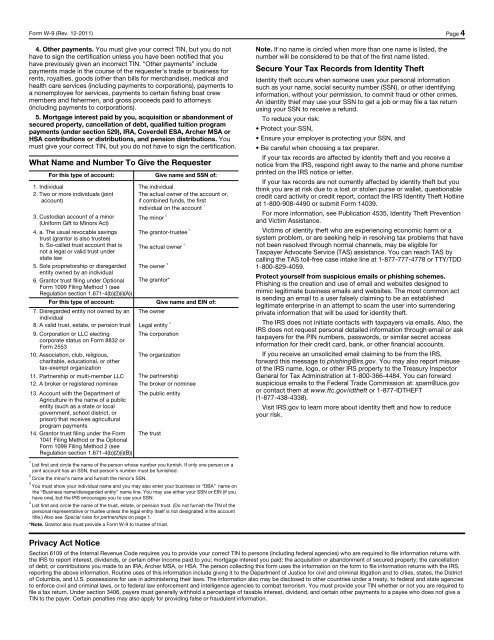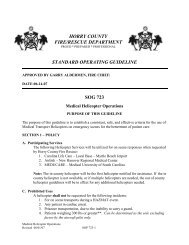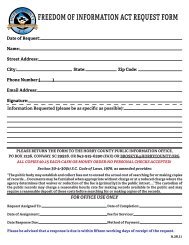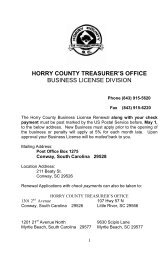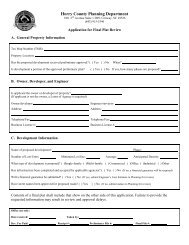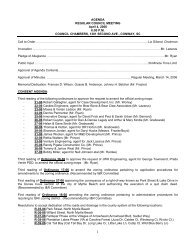PDF Bidder Application - Horry County Government
PDF Bidder Application - Horry County Government
PDF Bidder Application - Horry County Government
You also want an ePaper? Increase the reach of your titles
YUMPU automatically turns print PDFs into web optimized ePapers that Google loves.
Form W-9 (Rev. 12-2011) Page 44. Other payments. You must give your correct TIN, but you do nothave to sign the certification unless you have been notified that youhave previously given an incorrect TIN. “Other payments” includepayments made in the course of the requester’s trade or business forrents, royalties, goods (other than bills for merchandise), medical andhealth care services (including payments to corporations), payments toa nonemployee for services, payments to certain fishing boat crewmembers and fishermen, and gross proceeds paid to attorneys(including payments to corporations).5. Mortgage interest paid by you, acquisition or abandonment ofsecured property, cancellation of debt, qualified tuition programpayments (under section 529), IRA, Coverdell ESA, Archer MSA orHSA contributions or distributions, and pension distributions. Youmust give your correct TIN, but you do not have to sign the certification.What Name and Number To Give the RequesterFor this type of account:Give name and SSN of:1. Individual The individual2. Two or more individuals (joint The actual owner of the account or,account)if combined funds, the firstindividual on the account 13. Custodian account of a minor The minor 2(Uniform Gift to Minors Act)4. a. The usual revocable savings The grantor-trustee 1trust (grantor is also trustee)b. So-called trust account that is The actual owner 1not a legal or valid trust understate law5. Sole proprietorship or disregarded The owner 3entity owned by an individual6. Grantor trust filing under Optional The grantor*Form 1099 Filing Method 1 (seeRegulation section 1.671-4(b)(2)(i)(A))For this type of account:Give name and EIN of:7. Disregarded entity not owned by an The ownerindividual8. A valid trust, estate, or pension trust Legal entity 49. Corporation or LLC electingThe corporationcorporate status on Form 8832 orForm 255310. Association, club, religious,The organizationcharitable, educational, or othertax-exempt organization11. Partnership or multi-member LLC The partnership12. A broker or registered nominee The broker or nominee13. Account with the Department of The public entityAgriculture in the name of a publicentity (such as a state or localgovernment, school district, orprison) that receives agriculturalprogram payments14. Grantor trust filing under the Form The trust1041 Filing Method or the OptionalForm 1099 Filing Method 2 (seeRegulation section 1.671-4(b)(2)(i)(B))Note. If no name is circled when more than one name is listed, thenumber will be considered to be that of the first name listed.Secure Your Tax Records from Identity TheftIdentity theft occurs when someone uses your personal informationsuch as your name, social security number (SSN), or other identifyinginformation, without your permission, to commit fraud or other crimes.An identity thief may use your SSN to get a job or may file a tax returnusing your SSN to receive a refund.To reduce your risk:• Protect your SSN,• Ensure your employer is protecting your SSN, and• Be careful when choosing a tax preparer.If your tax records are affected by identity theft and you receive anotice from the IRS, respond right away to the name and phone numberprinted on the IRS notice or letter.If your tax records are not currently affected by identity theft but youthink you are at risk due to a lost or stolen purse or wallet, questionablecredit card activity or credit report, contact the IRS Identity Theft Hotlineat 1-800-908-4490 or submit Form 14039.For more information, see Publication 4535, Identity Theft Preventionand Victim Assistance.Victims of identity theft who are experiencing economic harm or asystem problem, or are seeking help in resolving tax problems that havenot been resolved through normal channels, may be eligible forTaxpayer Advocate Service (TAS) assistance. You can reach TAS bycalling the TAS toll-free case intake line at 1-877-777-4778 or TTY/TDD1-800-829-4059.Protect yourself from suspicious emails or phishing schemes.Phishing is the creation and use of email and websites designed tomimic legitimate business emails and websites. The most common actis sending an email to a user falsely claiming to be an establishedlegitimate enterprise in an attempt to scam the user into surrenderingprivate information that will be used for identity theft.The IRS does not initiate contacts with taxpayers via emails. Also, theIRS does not request personal detailed information through email or asktaxpayers for the PIN numbers, passwords, or similar secret accessinformation for their credit card, bank, or other financial accounts.If you receive an unsolicited email claiming to be from the IRS,forward this message to phishing@irs.gov. You may also report misuseof the IRS name, logo, or other IRS property to the Treasury InspectorGeneral for Tax Administration at 1-800-366-4484. You can forwardsuspicious emails to the Federal Trade Commission at: spam@uce.govor contact them at www.ftc.gov/idtheft or 1-877-IDTHEFT(1-877-438-4338).Visit IRS.gov to learn more about identity theft and how to reduceyour risk.1 List first and circle the name of the person whose number you furnish. If only one person on ajoint account has an SSN, that person’s number must be furnished.2 Circle the minor’s name and furnish the minor’s SSN.3 You must show your individual name and you may also enter your business or “DBA” name onthe “Business name/disregarded entity” name line. You may use either your SSN or EIN (if youhave one), but the IRS encourages you to use your SSN.4 List first and circle the name of the trust, estate, or pension trust. (Do not furnish the TIN of thepersonal representative or trustee unless the legal entity itself is not designated in the accounttitle.) Also see Special rules for partnerships on page 1.*Note. Grantor also must provide a Form W-9 to trustee of trust.Privacy Act NoticeSection 6109 of the Internal Revenue Code requires you to provide your correct TIN to persons (including federal agencies) who are required to file information returns withthe IRS to report interest, dividends, or certain other income paid to you; mortgage interest you paid; the acquisition or abandonment of secured property; the cancellationof debt; or contributions you made to an IRA, Archer MSA, or HSA. The person collecting this form uses the information on the form to file information returns with the IRS,reporting the above information. Routine uses of this information include giving it to the Department of Justice for civil and criminal litigation and to cities, states, the Districtof Columbia, and U.S. possessions for use in administering their laws. The information also may be disclosed to other countries under a treaty, to federal and state agenciesto enforce civil and criminal laws, or to federal law enforcement and intelligence agencies to combat terrorism. You must provide your TIN whether or not you are required tofile a tax return. Under section 3406, payers must generally withhold a percentage of taxable interest, dividend, and certain other payments to a payee who does not give aTIN to the payer. Certain penalties may also apply for providing false or fraudulent information.


